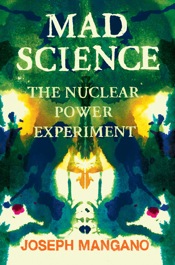
Joseph Mangano
Nuclear Lies, Cover-Ups and Secrecy
by JANETTE D. SHERMAN, MD
Do Governments and Corporations lie, cover-up and maintain secrecy as they harm our planet and us? Joe Mangano’s new book Mad Science – The Nuclear Power Experiment clearly lays it out that they have done so for more than half a century.
This book is a page-turner, filled with useful information that many of us don’t know or have forgot. His chapter “Tiny Atoms, Big Risks” explains the various forms of nuclear energy in terms that anyone can understand, and details the harm that has come to all life on our planet as a result of nuclear bombs and nuclear power plants.
Among the many nuclear catastrophes that Mangano chronicles – from Three Mile Island, the Nevada and Marshall Island nuclear bomb tests to Chernobyl and Fukushima- is the nuclear accident at the Santa Susana site in Ventura County, close to Los Angeles, CA. Santa Susana is one of the best-kept secrets in the history of nuclear power. The Santa Susana site had 10 sodium-cooled reactors the 1959 accident spewed radioactivity, tetralin – toxic naphthalene, and other chemicals into Simi Valley, the Pacific Ocean and eastward that are still detected over a half-century later.
A near meltdown of the Fermi-1 nuclear reactor nearly destroyed Detroit in 1968. It was a sodium-cooled reactor, as were the ones at Santa Susana. Located at the western end of Lake Erie, a Fermi meltdown would have crippled or destroyed much of the Great Lakes and St. Lawrence River as well. As has occurred since the Chernobyl meltdown, in the southern lake areas of Belarus, fish and boats travel upstream as well as down-stream.
As many as 16,000 workers were employed at Santa Susana by corporations that included, North American Aviation (a spin-of of General Motors), Rocketdyne, Atomics international and finally Boeing. Santa Susana was closed by 1980, but never fully decontaminated.
Everyone in the Los Angeles area who has had a family member with cancer, a low birth-weight child, death of an infant, or thyroid disease should read the book. So should those who live down-
wind of a nuclear test area or a nuclear power plant – which includes practically everyone in the United States and Canada.
It was Lewis Strauss, the first chairman of the Atomic Energy Commission who in 1954 touted nuclear power as “too cheap to meter.” Today we learn it is too costly to bury waste, clean up contaminated land and buildings, and too costly to build and maintain aging nuclear power and bomb plants.
Mangano observes: “Nuclear war, like any war, is not an inevitable force of nature, bit a conscious choice of leaders.” (p. 66) So too is any decision to build of maintain a nuclear site.
Since the Fukushima releases began, Japanese citizens are marching and protesting the continuation of nuclear power as they observe the obvious reality of contamination. How long will it take for U. S. citizens to demand a stop to nuclear power and its’ twin nuclear war weapons?
The book ($20 paperback, $10 ebook) is available at: www.orbooks.com.
Janette D. Sherman, M. D. is the author of Life’s Delicate Balance: Causes and Prevention of Breast Cancer and Chemical Exposure and Disease, and is a specialist in internal medicine and toxicology. She edited the book Chernobyl: Consequences of the Catastrophe for People and Nature, written by A. V. Yablokov, V. B., Nesterenko and A. V. Nesterenko, published by the New York Academy of Sciences in 2009. Her primary interest is the prevention of illness through public education. She can be reached at: toxdoc.js@verizon.net and www.janettesherman.com
Tip of the Hat to Contributing Editor Berto Jongman and CounterPunch.
See Also:
Charles Perrow, The Next Catastrophe: Reducing Our Vulnerabilities to Natural, Industrial, and Terrorist Disasters (Princeton, 2007)



